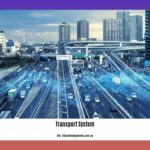Transport systems play a vital role in the development and progress of communities, offering a multitude of advantages that enhance accessibility, mobility, and economic growth. By ensuring efficient connectivity and reducing congestion, these systems facilitate seamless movement within and between cities, improving accessibility for residents and businesses alike. Moreover, they contribute to enhanced mobility, allowing individuals to easily access educational institutions, employment opportunities, healthcare facilities, and recreational areas. Furthermore, well-planned transport systems are a catalyst for economic growth, connecting regions and enabling the efficient movement of goods and services, thus promoting trade and attracting investments. In addition to these benefits, transport systems also have the potential to enhance environmental sustainability by reducing greenhouse gas emissions through the promotion of public transportation and the adoption of eco-friendly practices. In this article, we will explore the numerous advantages that transport systems offer, highlighting their role in transforming communities and fostering prosperity.
Key Takeaways:
Improved community mobility: Transportation allows for convenient and quick travel, providing access to essential services, education, healthcare, and employment opportunities.
Flexible service: Transportation offers various options such as public transportation, taxis, ride-sharing, and delivery services, catering to individual and community needs.
Less capital outlay: By reducing the need for personal vehicles, transportation alternatives such as public transportation alleviate the financial burden on individuals, freeing up funds for other purposes.
Rapid speed: Fast transportation modes like airplanes and high-speed trains significantly reduce travel time, increasing efficiency and productivity.
Door-to-door service: Many transportation options provide door-to-door service, eliminating the hassle of parking and navigating unfamiliar areas.
Economic growth: Transportation contributes to trade and commerce, enhancing a nation’s economy by increasing efficiency, productivity, and job opportunities in the transportation industry.
Advantages of Transport Systems

Transportation is a critical aspect of modern society, and it brings numerous advantages that improve accessibility, mobility, and economic growth. In this article, we will explore the various benefits that a well-developed transport system offers to individuals, communities, and nations.
Improved Community Mobility
One of the significant advantages of a robust transport system is improved community mobility. It enables people to travel quickly and conveniently, making it easier to access essential services, education, healthcare, and employment opportunities. Whether it’s public transportation, taxis, or ride-sharing services, a well-functioning transport system allows individuals to reach their desired destinations efficiently. This improved mobility contributes to the overall development and well-being of communities.
Flexible Service
Transportation offers flexible services that cater to the diverse needs of individuals and communities. People have options like public transportation, taxis, ride-sharing services, and delivery services at their disposal, allowing them to choose the most suitable mode of transportation based on their specific requirements. This flexibility ensures that everyone can access transportation services that meet their unique needs, enhancing convenience and satisfaction.
Less Capital Outlay
Owning and maintaining personal vehicles can be financially burdensome. However, a well-developed transport system offers viable alternatives, such as public transportation. Choosing these alternatives helps individuals save on significant capital outlay by eliminating the need to purchase and maintain personal vehicles. By reducing the financial burden associated with car ownership, individuals can free up funds for other purposes, contributing to a better quality of life.
Rapid Speed
Transportation plays a vital role in enabling quick and efficient movement of people and goods. Fast modes of transportation like airplanes and high-speed trains significantly reduce travel time, enhancing efficiency and productivity. With the ability to traverse long distances in a relatively short time, these modes of transport facilitate fast-paced travel, benefitting both individuals and businesses alike.
Door-to-Door Service
Convenience is a key advantage of a well-developed transport system. Many transportation options, such as public transportation, taxis, and delivery services, provide door-to-door service. This eliminates the hassles of parking and navigating through unfamiliar areas, offering a seamless travel experience. With door-to-door service, individuals can enjoy the benefits of convenience and ease while traveling to their desired destinations.
Facilitating Trade and Commerce
Transportation has a significant impact on trade and commerce, contributing to a nation’s economic growth. An efficient transport system enhances the movement of goods, reducing logistics costs and improving overall supply chain efficiency. This, in turn, stimulates trade and fosters economic development. Additionally, the transportation industry itself creates job opportunities, ranging from truck drivers and bus drivers to pilots and locomotive engineers. These employment opportunities further contribute to the economic well-being of individuals and communities.
In conclusion, a well-functioning transport system brings numerous advantages to individuals, communities, and economies. It improves community mobility, provides flexible services, reduces capital outlay, enables rapid speed, offers door-to-door service, and facilitates trade and commerce. These advantages enhance accessibility, mobility, and economic growth within societies, making a strong case for continued investments in developing and optimizing transport systems.
Here are some links related to the advantages of different transportation systems:
Advantages of Traffic Light Control System: Discover the benefits of implementing a traffic light control system for efficient and organized traffic management.
Advantages of Traffic Management System: Explore the advantages of using a traffic management system to improve traffic flow and reduce congestion on roadways.
Advantages of Using Sea Transport: Uncover the numerous advantages of utilizing sea transport for cost-effective and environmentally friendly shipping solutions.
Advantages of Using Water Transport: Dive into the advantages of using water transport as an efficient and economical mode of transportation for goods and people.
Advantages of Water Transport: Learn about the advantages of water transport, such as its ability to handle large cargo volumes and provide access to remote areas.
Advantages of Water Transport System: Find out why a well-designed water transport system offers advantages such as reduced traffic congestion and lower carbon emissions.
Take a moment to click on the links above to explore the advantages each transportation system has to offer.
The Advantages of Transport Systems: Improving Accessibility, Mobility, and Economic Growth

Transport systems play a vital role in promoting economic growth and enhancing the overall well-being of communities. By providing efficient and reliable transportation options, these systems contribute to improved accessibility, mobility, and economic prosperity. In this article, we will explore the various advantages of transport systems, with a specific focus on the promotion of economic growth.
The Economic Impact of Transport Systems
Transportation serves as a key driver of economic growth by connecting goods and services to markets. It enables businesses to access a larger customer base, promotes trade and commerce, and contributes to job creation. As a result, a well-developed transport system can stimulate economic development and improve the overall prosperity of a region[^2].
But how exactly does a robust transport system promote economic growth? Let’s delve deeper into the specific advantages it brings:
1. Facilitating Trade and Commerce
A well-functioning transport system enhances the movement of goods and reduces logistics costs, making it easier for businesses to engage in trade and commerce. Whether it’s by road, rail, air, or water, efficient transportation infrastructure streamlines supply chains and reduces delivery times, enabling businesses to operate more efficiently.
2. Supporting Job Creation
The transportation industry itself creates numerous job opportunities, ranging from drivers and logistics staff to engineers and maintenance personnel. Additionally, improved accessibility through reliable transport systems allows individuals to easily access employment opportunities, thus reducing unemployment rates and contributing to economic well-being.
3. Boosting Productivity and Efficiency
Fast modes of transportation, such as airplanes and high-speed trains, significantly reduce travel time, enhancing efficiency and productivity. This allows individuals and businesses to save valuable time and allocate resources more effectively. Moreover, a well-developed transport system ensures reliable and timely delivery, reducing delays and allowing businesses to meet customer demands promptly.
4. Attracting Investments and Businesses
Regions with well-developed transport systems are more likely to attract investments and businesses. Investors are drawn to areas with efficient transport infrastructure as it provides the necessary means to transport resources, materials, and products smoothly. The presence of reliable transportation options enhances connectivity and accessibility, making an area more appealing for businesses to set up operations.
5. Improving Access to Markets and Opportunities
Transportation systems improve accessibility, allowing individuals to access essential services, education, healthcare, and employment opportunities with greater ease. By connecting people to markets and resources, transport systems provide individuals with avenues for economic advancement and overall well-being. This improved access fosters economic inclusivity and reduces disparities between different regions.
Key Takeaways:
- A well-developed transport system promotes economic growth by facilitating trade and commerce.
- Improved accessibility through transport systems supports job creation and reduces unemployment rates.
- Fast modes of transportation enhance productivity and efficiency by reducing travel time.
- Efficient transport infrastructure attracts investments and businesses to a region.
- Transport systems improve access to markets and opportunities, promoting economic inclusivity and reducing disparities.
Citations:
1. World Bank Group. “Transport Overview.” World Bank Group. Link
2. ResearchGate: “The Role of the Transport System in Stimulating Economic Development” Link
The Enhancement of Environmental Sustainability
Transportation plays a crucial role in shaping the sustainability of our communities and the environment. A well-developed transport system not only improves accessibility, mobility, and economic growth but also enhances environmental sustainability. By embracing sustainable transportation practices, we can protect our planet and promote a greener future. Let’s explore the advantages of sustainable transportation and how it contributes to environmental sustainability.
Reduced Environmental Footprint
Sustainable transportation significantly reduces the environmental footprint associated with commuting and transportation activities. By promoting the use of clean and efficient modes of transportation such as public transit, cycling, and walking, it helps to minimize greenhouse gas emissions, air pollution, and noise pollution. The result is a healthier environment and a reduction in the negative impacts on ecosystems and human health.
Improved Public Health
Sustainable transportation options like walking and cycling have positive impacts on public health. They encourage physical activity, decrease sedentary behaviors, and reduce the risk of chronic diseases such as obesity, heart disease, diabetes, and cancer. Additionally, by reducing air pollution and promoting cleaner air quality, sustainable transportation helps improve respiratory health and reduce instances of respiratory illnesses.
Economic Benefits
Sustainable transportation initiatives bring about economic advantages. Investments in sustainable transportation infrastructure generate job opportunities in construction, maintenance, and operations. Furthermore, sustainable transportation contributes to cost savings for individuals and communities by reducing fuel expenses, vehicle maintenance costs, and the need for parking infrastructure. These economic benefits contribute to the overall well-being and prosperity of communities.
Enhanced Mobility and Accessibility
Sustainable transportation seeks to improve mobility options and accessibility for all individuals, including those with limited mobility or disabilities. It aims to create an integrated and inclusive transportation system that provides convenient and affordable transportation choices. By enhancing the availability of sustainable transportation modes, people can access employment, education, healthcare, and other essential services without relying heavily on private vehicles.
Reduced Traffic Congestion
Sustainable transportation can alleviate traffic congestion in cities and urban areas. By promoting the use of public transit, carpooling, and active modes of transportation, it reduces the number of cars on the road and eases traffic flow. This leads to shorter travel times, increased road capacity, and improved overall transportation efficiency. By reducing congestion, sustainable transportation not only saves time for individuals but also reduces fuel consumption and associated greenhouse gas emissions.
Preservation of Natural Resources
Sustainable transportation contributes to the preservation of natural resources. It reduces the dependence on fossil fuels and non-renewable energy sources by encouraging the use of renewable energy in transportation, such as electric vehicles or public transit systems powered by clean energy sources. Additionally, sustainable transportation promotes smart land use planning that protects natural habitats and reduces urban sprawl, preserving our ecosystems for future generations.
Climate Change Mitigation
Sustainable transportation plays a crucial role in mitigating climate change. By reducing greenhouse gas emissions from the transportation sector, it helps to mitigate the effects of global warming and minimize the contribution of transportation to climate change. This is achieved through the adoption of low-carbon technologies, fuel efficiency improvements, and modal shifts towards greener alternatives. The enhancement of environmental sustainability is essential in our collective efforts to combat climate change.
Resilient and Livable Communities
Sustainable transportation promotes the development of resilient and livable communities. It fosters the creation of walkable and bike-friendly neighborhoods, with well-connected and accessible public transportation systems. This enhances community cohesion, social interaction, and a sense of place. By reducing the need for large-scale infrastructure projects that can have adverse impacts on communities and the environment, sustainable transportation helps create communities that are environmentally friendly, economically robust, and socially vibrant.
Key Takeaways:
- Sustainable transportation significantly reduces the environmental footprint by minimizing greenhouse gas emissions, air pollution, and noise pollution.
- Sustainable transportation options like walking and cycling improve public health by encouraging physical activity and reducing the risk of chronic diseases.
- Investments in sustainable transportation infrastructure generate job opportunities and lead to cost savings for individuals and communities.
- By enhancing mobility and accessibility, sustainable transportation allows individuals to access employment, education, healthcare, and other essential services easily.
- Sustainable transportation reduces traffic congestion, resulting in shorter travel times, increased road capacity, and improved overall transportation efficiency.
- It contributes to the preservation of natural resources by promoting the use of renewable energy in transportation and protecting natural habitats.
- Sustainable transportation plays a crucial role in mitigating climate change by reducing greenhouse gas emissions from the transportation sector.
- It fosters the development of resilient and livable communities, promoting community cohesion, social interaction, and a sense of place.
Sources:
1. ScaleClimateAction.org: Transportation
2. UCLA Transportation: 5 Environmental Benefits of Sustainable Transportation
The Positive Effects on Public Health
Public transportation has numerous positive effects on public health, contributing to the overall well-being of individuals and communities. By promoting accessibility, reducing air pollution, and encouraging physical activity, public transportation plays a vital role in creating healthier environments. In this article, we will explore the positive effects of public transportation on public health and the benefits they bring.
Promoting Accessibility and Equity
Public transportation offers accessible and affordable transportation options for people of all socioeconomic backgrounds. It bridges the gap between neighborhoods, ensuring that individuals can access essential services such as healthcare facilities and education institutions without the need for private vehicles. The availability of reliable public transportation enables individuals to connect with job opportunities and participate in community activities, promoting inclusivity and improving overall access to resources.
Reducing Air Pollution
One of the significant positive effects of public transportation on public health is the reduction of air pollution. Individual vehicles are a major contributor to air pollution, releasing harmful pollutants that can have adverse effects on respiratory health and overall well-being. By reducing the number of cars on the road and encouraging shared transit options, public transportation significantly decreases emissions of pollutants such as carbon monoxide and nitrogen dioxide. This leads to improved air quality and a healthier environment for everyone.
Encouraging Physical Activity
Using public transportation often involves walking or cycling to and from transit stops, promoting physical activity as part of individuals’ daily routines. Regular physical activity has numerous health benefits, including reducing the risk of chronic diseases such as obesity, heart disease, and diabetes. Incorporating physical activity into daily commutes through the use of public transportation helps individuals maintain an active lifestyle, contributes to overall fitness, and improves cardiovascular health.
Fostering Social Connections
Public transportation provides opportunities for social interaction, fostering a sense of community and well-being. Commuting on public transit allows individuals to engage with their surroundings, interact with fellow commuters, and build connections. These social connections play a crucial role in promoting mental health, reducing loneliness, and enhancing overall well-being.
Key Takeaways:
- Public transportation promotes accessibility and equity by providing affordable transportation options for people of all socioeconomic backgrounds.
- Public transportation reduces air pollution by decreasing the number of individual cars on the road and reducing emissions of harmful pollutants.
- Using public transportation encourages physical activity, contributing to overall fitness and reducing the risk of chronic diseases.
- Public transportation fosters social connections and enhances community well-being by providing opportunities for social interaction.
Sources:
1. The Costs and Benefits of Private and Public Transport Systems
2. Environment, Climate Change and Health – World Health Organization
FAQ
Q1: What are the advantages of a well-functioning transport system?
A1: A well-functioning transport system provides improved community mobility, flexible service options, less capital outlay, rapid speed, and door-to-door service. It also promotes economic growth and enhances environmental sustainability.
Q2: How does transportation improve community mobility?
A2: Transportation allows people to travel quickly and conveniently, providing access to places that would otherwise be difficult to reach. This improves community mobility and enhances people’s ability to access services, education, healthcare, and employment opportunities.
Q3: What are some flexible service options provided by transportation?
A3: Transportation provides flexible services that can adapt to the needs of individuals and communities. It offers various options such as public transportation, taxis, ride-sharing services, and delivery services, allowing people to choose the most suitable mode of transportation for their needs.
Q4: How does transportation contribute to economic growth?
A4: Improved transportation systems increase efficiency and productivity, leading to economic growth. The transportation industry also provides job opportunities, including truck drivers, bus drivers, pilots, locomotive engineers, and more.
Q5: How does transportation benefit the environment?
A5: Transportation plays a vital role in facilitating trade and commerce, contributing to a nation’s economy. Additionally, transportation can promote environmental sustainability by reducing congestion, improving air quality, and lowering the carbon footprint through the use of sustainable modes of transportation and clean energy sources.
- Mastering Leader in Spanish: The Complete Guide - April 19, 2025
- Uncovering Surprising Parallels: England Size Compared to US States - April 19, 2025
- Old Mexico Map: Border Shifts 1821-1857 - April 19, 2025
















